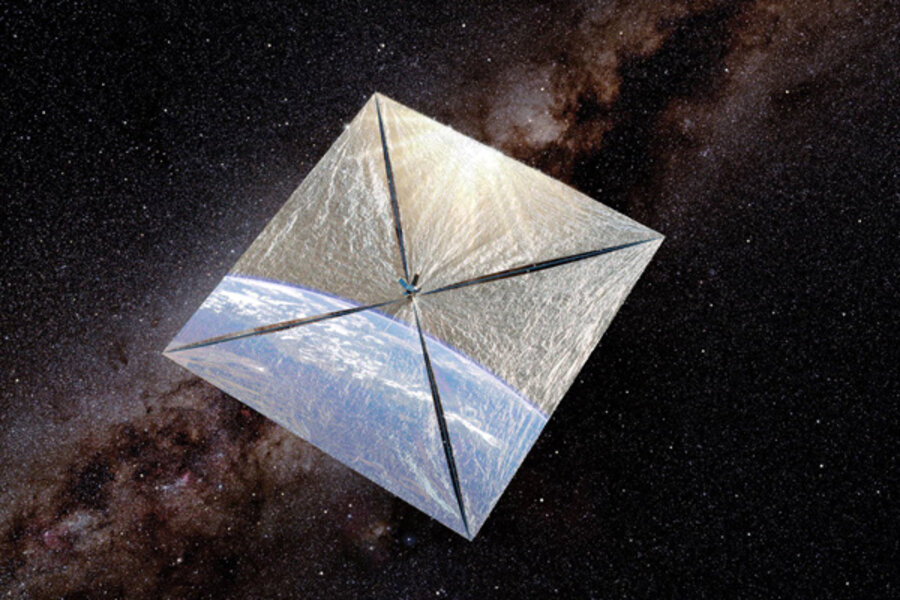Solar Sail flotilla could prevent potential giant asteroid impact
Loading...
A flotilla of solar sail spacecraft could change the course of the asteroid Apophis — which is headed a little too close to Earth for comfort — by shading the space rock from solar radiation, according to a French researcher.
Such a plan could help shift Apophis into a slightly safer orbit by the time it is expected to swing by Earth on April 13, 2036. But experts have warned previously that any efforts to divert the space rock could actually make matters worse.
The preliminary concept idea was proposed at a symposium on solar sails – which are spacecraft powered by sunlight pushing against a sail – a few months ago at the New York City College of Technology in Brooklyn.
"Apophis is a nice target for launching this kind of mission for 20 years from now; not too far, not too close," said Jean-Yves Prado, an engineer at the National Center for Space Study (CNES) in France.
How to move a space rock
A group of formation-flying solar sails could alter the asteroid's course by eliminating the so-called Yarkovsky effect, a phenomenon described by Russian engineer I.O. Yarkovsky a century ago.
That effect occurs when the sun warms an asteroid more on the sun-facing side than the far side. The rock then emits more thermal radiation on its near side, which creates a bit of thrust and changes its momentum slightly.
"It's really a very small effect and doesn't apply to very small asteroids because the temperature would be quite negligible, so thrust is negligible," Prado explained. "It also does not apply to very large asteroids because they are too heavy."
But for Apophis, which falls just in the middle of that mass range, the effect could make a difference.
The proposed mission would deploy four 441-pound (200 kg) solar sails from a transfer module that used solar electric propulsion to reach Apophis. Previous spacecraft that have used solar electric propulsion include NASA's Deep Space 1 and Dawn probes.
Once deployed, the solar sails would hover a few kilometers above the space rock and fly in formation according to master control by the transfer module, without a direct link between Earth and the individual sails.
The module could also position itself as a small gravity tractor to provide a small gravitational push on Apophis, Prado suggested.
Practical concerns arise
A previous NASA assessment of possible asteroid deflection methods had placed solar sails relatively high in terms of readily available and not-too-complex technology.
Launch windows would become available for such a mission to launch aboard a Russian Soyuz-Fregat rocket in 2016 and 2019, Prado said. He added that a second redundant mission could also launch to ensure success.
Several other solar sail researchers at the symposium raised questions about the mission design. One questioned the need for a chemical propulsion system on each solar sail that would balance out the solar pressure and keep the sails flying in their proper place.
Prado replied that his group had examined the possibility of using solar electric propulsion to also maintain low thrust and keep the solar sails in place, but had ruled it out based on cost.
Another researcher suggested that simply crashing four spacecraft with the mass of the solar sails into Apophis might be simpler.
The long view
An earlier, unrelated Russian proposal to nudge the space rock aside has been met with skepticism, in part because any solution might worsen Earth's chances, given the uncertainty regarding Apophis' exact trajectory.
NASA scientists previously pegged the possibility of an Apophis collision with Earth at a low 1-in-250,000 chance in 2036, when Apophis is expected to approach within 18,300 miles (29,450 km) of the planet in 2036.
The asteroid's second near pass by Earth comes in 2068, when it has a three-in-a-million chance (or about 1-in-333,000) of impacting on the planet.
Whether or not solar sails prove instrumental in protecting Earth from asteroids, proponents of the technology are excited about the progress they've made.
In July 2010, Japan's Ikaros spacecraft became the first vehicle to have deployed a solar sail and successfully rode the sunlight in deep space. Another effort by Britain called CubeSail, slated to launch next year, will use a solar sail as an atmospheric brake and will possibly be used to take down pieces of space junk.





